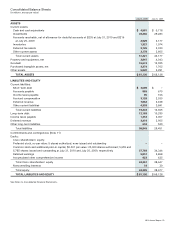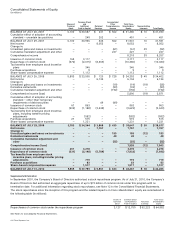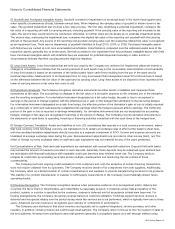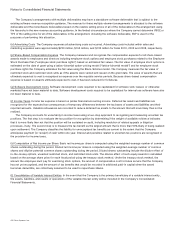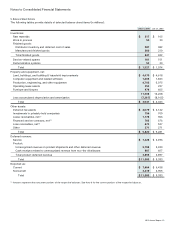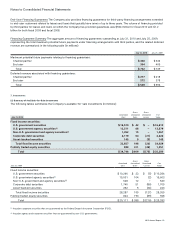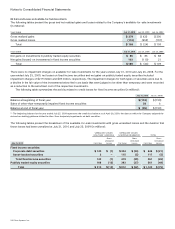Cisco 2010 Annual Report Download - page 49
Download and view the complete annual report
Please find page 49 of the 2010 Cisco annual report below. You can navigate through the pages in the report by either clicking on the pages listed below, or by using the keyword search tool below to find specific information within the annual report.
Notes to Consolidated Financial Statements
In many instances, products are sold separately in standalone arrangements as customers may support the products
themselves or purchase support on a time-and-materials basis. Advanced services are sometimes sold in standalone engagements
such as general consulting, network management, or security advisory projects and technical support services are sold separately
through renewals of annual contracts. As a result, for substantially all of the arrangements with multiple deliverables pertaining to
routing and switching products and related services, as well as most arrangements containing advanced and emerging
technologies, the Company has used and intends to continue using VSOE to allocate the selling price to each deliverable.
Consistent with its methodology under previous accounting guidance, the Company determines VSOE based on its normal pricing
and discounting practices for the specific product or service when sold separately. In determining VSOE, the Company requires that
a substantial majority of the selling prices for a product or service fall within a reasonably narrow pricing range, generally evidenced
by approximately 80% of such historical standalone transactions falling within plus or minus 15% of the median rates. In addition,
the Company considers the geographies in which the products or services are sold, major product and service groups and
customer classifications, and other environmental or marketing variables in determining VSOE.
In certain limited instances, the Company is not able to establish VSOE for all deliverables in an arrangement with multiple
elements. This may be due to the Company infrequently selling each element separately, not pricing products within a narrow
range, or only having a limited sales history, such as in the case of certain advanced and emerging technologies. When VSOE
cannot be established, the Company attempts to establish selling price of each element based on TPE. TPE is determined based on
competitor prices for similar deliverables when sold separately. Generally, the Company’s go-to-market strategy typically differs
from that of its peers and its offerings contain a significant level of customization and differentiation such that the comparable
pricing of products with similar functionality cannot be obtained. Furthermore, the Company is unable to reliably determine what
similar competitor products’ selling prices are on a standalone basis. Therefore, the Company is typically not able to determine
TPE.
When the Company is unable to establish selling price using VSOE or TPE, the Company uses ESP in its allocation of
arrangement consideration. The objective of ESP is to determine the price at which the Company would transact a sale if the
product or service were sold on a standalone basis. ESP is generally used for new or highly customized offerings and solutions or
offerings not priced within a narrow range, and it applies to a small proportion of the Company’s arrangements with multiple
deliverables.
The Company determines ESP for a product or service by considering multiple factors, including, but not limited to,
geographies, market conditions, competitive landscape, internal costs, gross margin objectives, and pricing practices. The
determination of ESP is made through consultation with and formal approval by the Company’s management, taking into
consideration the go-to-market strategy.
The Company regularly reviews VSOE, TPE, and ESP and maintains internal controls over the establishment and updates of
these estimates. There were no material impacts during the fiscal year nor does the Company currently expect a material impact in
the near term from changes in VSOE, TPE, or ESP.
Net sales as reported for the fiscal year ended July 31, 2010, and the Company’s estimate of the pro forma net sales that
would have been reported if the transaction entered into or materially modified during fiscal 2010 were subject to previous
accounting guidance, are shown in the following table (in millions):
FISCAL YEAR ENDED JULY 31, 2010
As Reported
Pro Forma Basis as if the
Previous Accounting Guidance Were
in Effect
Net sales $ 40,040 $ 39,802
The estimated impact to net sales of the accounting standard was primarily to net product sales.
The new accounting standards for revenue recognition if applied in the same manner to the year ended July 25, 2009 would
not have had a material impact on net sales for that fiscal year. In terms of the timing and pattern of revenue recognition, the new
accounting guidance for revenue recognition is not expected to have a significant effect on net sales in periods after the initial
adoption when applied to multiple-element arrangements based on current go-to-market strategies due to the existence of VSOE
across most of the Company’s product and service offerings. However, the Company expects that this new accounting guidance
will facilitate the Company’s efforts to optimize its offerings due to better alignment between the economics of an arrangement and
the accounting. This may lead to the Company engaging in new go-to-market practices in the future. In particular, the Company
expects that the new accounting standards will enable it to better integrate products and services without VSOE into existing
offerings and solutions. As these go-to-market strategies evolve, the Company may modify its pricing practices in the future, which
could result in changes in selling prices, including both VSOE and ESP. As a result, the Company’s future revenue recognition for
multiple-element arrangements could differ materially from the results in the current period. The Company is currently unable to
determine the impact that the newly adopted accounting guidance could have on its revenue as these go-to-market strategies
evolve.
2010 Annual Report 47




